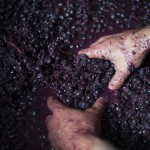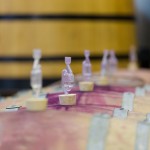The Winemaker’s Think Tank: Vol 36 – “If I want to make a blend, do I mix the grapes together when I crush, or ferment them separately and blend later?”
What’s the Winemaker’s Think Tank?
Every Thursday we will post about a few frequently asked questions that our winemaker has answered. If you have a winemaking question you would like to have answered, please email us at support@juicegrape.com and we will try to get into next week’s post. Cheers! 🙂
If I want to make a blend, do I mix the grapes together when I crush, or ferment them separately and blend later?
There are many approaches to creating a blended wine and the chosen path is directly influenced by the desired end result. Blending at crush is often referred to as a field blend. The winemaker may choose to blend at crush when 80% of the blend is one grape. Using cabernet sauvignon as an example, a winemaker may add in a crate or two of Petite Syrah or Petite Verdot to enhance the dark color of the Cabernet Sauvignon. The winemaker may choose to add a crate or two of Cabernet Franc to enhance the spiciness and perceived acidity of the wine. Adding a small amount of a different grape to the larger percentage of the dominant grape in a blend will change the wine subtly, enhancing an aspect of the original grape that may be lacking such as color or acidity.
If the winemaker would prefer to have greater and much more finite control over the flavors in the resulting blend, fermenting each varietal individually would be more advantageous. Different yeast strains may be used on different varietals to enhance specific varietal characters. After a period of separate bulk aging, the wine maker can make different sample blends to determine the final blend of the wines they desire. Perhaps the entire quantity of a varietal will not be needed for the blend or perhaps only small additions of one varietal to another will be necessary to create a balanced final product. The winemaker can create more than one blend with a few separately vinified wines as changing the varietal percentages can greatly affect the final product.
We hope this information helps with your winemaking. If you have any follow up questions or winemaking questions in general, please email us at support@juicegrape.com.
The Winemaker’s Think Tank: Vol 35 – How do I know if fermentation is complete?
What’s the Winemaker’s Think Tank?
Every Thursday we will post about a few frequently asked questions that our winemaker has answered. If you have a winemaking question you would like to have answered, please email us at support@juicegrape.com and we will try to get into next week’s post. Cheers! 🙂
How do I know if fermentation is complete?
It is often easy to see visual signs of fermentation: from activity in the airlock, bubbles, and the formation of a cap to the aromas of yeast and carbon dioxide, the wonders of fermentation are succinct observation. But how does the home winemaker know when the fermentation is complete? The simplest way of seeing if fermentation is complete is to taste the wine and observe if there is any sweetness to it. If there is still sugar that you can taste, the yeast have not yet completed their job. The most accurate and scientific way of seeing if fermentation is complete is to take a measurement of the Brix via a hydrometer. A hydrometer is a glass instrument that reads sugar content via the hydrometers buoyancy in wine juice. The juice sample should always be placed into a sanitary, cylindrical shaped vessel. As the wine ferments, yeast consumer sugar and excrete alcohol, making a thinner, less dense liquid. At the beginning of fermentation, the hydrometer will not sink very far into the wine. The sugars within the juice make it thicker and the hydrometer will float on top of the juice. As fermentation progresses the new wine becomes less dense and sugary, allowing the hydrometer to sink down into the liquid. When the fermentation is complete, the hydrometer will sink down into the liquid to the 0 mark, if not farther. When reading the hydrometer, spin it slightly in the cylinder to dislodge any bubbles that may cling to the sides of the hydrometer. Observe where the meniscus of the wine falls on the gradients of the hydrometer. This will give you your sugar level in degrees Brix of the fermenting wine. When the hydrometer sinks to zero or below, the fermentation is complete and you can rack the wine.
We hope this information helps with your winemaking. If you have any follow up questions or winemaking questions in general, please email us at support@juicegrape.com.
The Winemaker’s Think Tank: Vol 13- What’s the best way to add sulfite to my wine?
What’s the Winemaker’s Think Tank?
Every Thursday we will post about a few frequently asked questions that our winemaker has answered. If you have a winemaking question you would like to have answered, please email us at support@juicegrape.com and we will try to get into next week’s post. Cheers! 🙂
What’s the best way to add sulfite to my wine?
There are two effective methods of sulfite addition to wine. Campden tablets are small tablets of sulfite that are a pre-measured dose meant to add 25ppm to 5 gallons of wine. The drawback to these tablets is that sometimes they do not dissolve completely. The most effective way to add sulfites into wine is via powdered potassium metabisulfite. Winemaker Magazine offers a sulfite calculator on their website that is very useful in helping a winemaker figure out an exact dosage of sulfites for their wine. To use this calculator, one must know the volume and pH of the wine to be treated. The average rate of application for potassium metabisulfite is ¼ tsp/5 gallons to raise the sulfites by 50ppm. The sulfite calculator is a better option as it will help you find and exact dosage needed for your wine contingent upon the wines’ pH and stability.
We hope this information helps with your winemaking. If you have any follow up questions or winemaking questions in general, please email us at support@juicegrape.com.
The Winemaker’s Think Tank: Vol 11 – Spring Wine Yeast Suggestions: Cabernet Sauvignon

What’s the Winemaker’s Think Tank?
Every Thursday we will post about a few frequently asked questions that our winemaker has answered. If you have a winemaking question you would like to have answered, please email us at support@juicegrape.com and we will try to get into next week’s post. Cheers! 🙂
Varietal Country of Origin Yeast Strain Yeast Attributes:
Cabernet Sauvignon – Chile/South Africa
- Chile- CSM Diminishes vegetal character: 25Brix/14%ABV /High
- South Africa- CSM/D254 CSM Diminishes vegetal character 25Brix/14%ABV/High while D254 promotes fruit character, berry, plum, mild spice- 29Brix/16%ABV/ Medium
Malbec – Chile/Argentina
- D254 Promotes fruit character, berry, plum, mild spice- 29Brix/16%ABV/ Medium
Carmenere – Chile
- D254 Promotes fruit character 29/16%ABV medium
- BDX Soft tannins, secures color, low heat 29/16% ABV medium
Pinotage – South Africa
- BM 4×4 Very reliable, increased color, palate length 27/15%ABV high
- D80 Increases mouthfeel and tannin integration 29/16%ABV high
Chardonnay – Chile
- QA23 Promotes apple and pear notes 29/16%ABV low
- Vin 13 Promotes pineapple and tropical notes in SS 30/16.5%ABV low
Sauvignon Blanc – Chile
- 71B Promotes grapefruit & tropical notes 25/14%ABV low
- R2 Promotes fruit and floral notes 29/16%ABV high
- QA23 Promotes passion fruit 29/16%ABV low
We hope this information helps with your winemaking. If you have any follow up questions or winemaking questions in general, please email us at support@juicegrape.com.









Recent Comments